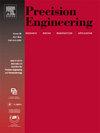Nd-Fe-B micro-magnet machined by diamond wire sawing: An approach on surface integrity and magnetic properties
IF 3.7
2区 工程技术
Q2 ENGINEERING, MANUFACTURING
Precision Engineering-Journal of the International Societies for Precision Engineering and Nanotechnology
Pub Date : 2025-03-25
DOI:10.1016/j.precisioneng.2025.03.025
引用次数: 0
Abstract
This study investigates the effect of diamond wire sawing on the surface integrity and magnetic properties of machined Nd-Fe-B micro-magnets. A diamond wire saw was employed to cut micro-magnets from larger sintered Nd-Fe-B magnets, varying wire cutting speed (vc), feed rate (vf), and micro-magnet thickness. Surface integrity and magnetic properties of micro-magnets were analyzed. The results showed that surface morphology presented microgrooving and microcutting predominance at higher vc, while crater formation increased with higher vf. The minimum surface roughness values achieved were Sa = 0.32 μm, Sq = 0.41 μm, and Sz = 5.93 μm. Subsurface damage included Nd2Fe14B grain pullout and intergranular microcracks, and chips exhibited a fragment-like morphology. A micro-magnet thickness of 80.4 ± 4.6 μm was successfully obtained at vc = 5 m/s, whereas cutting micro-magnets <200 μm was challenging at 15–25 m/s. A reduction in micro-magnet thickness led to a decline in magnetic properties: for the 80.4 ± 4.6 μm micro-magnet, Hcj was 1209.5 kA/m and (BH)max was 217.3 kJ/m3, whereas for the 495.0 ± 8.2 μm micro-magnet, Hcj reached 1403.4 kA/m and (BH)max was 286.2 kJ/m3. The decrease in magnetic properties correlated with an increase in the machined surface-to-volume ratio. These findings indicate that diamond wire sawing is a promising micromachining process for Nd-Fe-B micro-magnets, ensuring high surface quality while maintaining excellent magnetic properties.

金刚石线锯加工Nd-Fe-B微磁体:表面完整性和磁性能的研究
研究了金刚石线切割对加工后Nd-Fe-B微磁体表面完整性和磁性能的影响。采用金刚石线锯切割较大烧结Nd-Fe-B磁体,改变线切割速度(vc)、进给速度(vf)和微磁体厚度。分析了微磁体的表面完整性和磁性能。结果表明:高vc时,表面形貌以微沟槽和微切割为主,而随着vf的增大,陨坑形成增多;获得的最小表面粗糙度值为Sa = 0.32 μm, Sq = 0.41 μm, Sz = 5.93 μm。亚表面损伤主要表现为Nd2Fe14B晶粒脱拉和晶间微裂纹,切屑形貌呈碎片状。在vc = 5 m/s的速度下,成功地获得了80.4±4.6 μm的微磁体厚度,而在15 ~ 25 m/s的速度下,切割200 μm的微磁体具有挑战性。微磁体厚度的减小导致磁性能的下降:80.4±4.6 μm微磁体的Hcj为1209.5 kA/m, (BH)max为217.3 kJ/m3; 495.0±8.2 μm微磁体的Hcj为1403.4 kA/m, (BH)max为286.2 kJ/m3。磁性能的降低与加工表面体积比的增加有关。这些研究结果表明,金刚石线锯是一种很有前途的Nd-Fe-B微磁体微加工工艺,在保证高表面质量的同时保持优异的磁性能。
本文章由计算机程序翻译,如有差异,请以英文原文为准。
求助全文
约1分钟内获得全文
求助全文
来源期刊
CiteScore
7.40
自引率
5.60%
发文量
177
审稿时长
46 days
期刊介绍:
Precision Engineering - Journal of the International Societies for Precision Engineering and Nanotechnology is devoted to the multidisciplinary study and practice of high accuracy engineering, metrology, and manufacturing. The journal takes an integrated approach to all subjects related to research, design, manufacture, performance validation, and application of high precision machines, instruments, and components, including fundamental and applied research and development in manufacturing processes, fabrication technology, and advanced measurement science. The scope includes precision-engineered systems and supporting metrology over the full range of length scales, from atom-based nanotechnology and advanced lithographic technology to large-scale systems, including optical and radio telescopes and macrometrology.

 求助内容:
求助内容: 应助结果提醒方式:
应助结果提醒方式:


